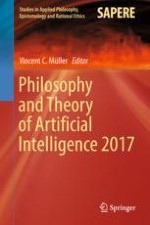2018 | OriginalPaper | Buchkapitel
Where Intelligence Lies: Externalist and Sociolinguistic Perspectives on the Turing Test and AI
verfasst von : Shlomo Danziger
Erschienen in: Philosophy and Theory of Artificial Intelligence 2017
Aktivieren Sie unsere intelligente Suche, um passende Fachinhalte oder Patente zu finden.
Wählen Sie Textabschnitte aus um mit Künstlicher Intelligenz passenden Patente zu finden. powered by
Markieren Sie Textabschnitte, um KI-gestützt weitere passende Inhalte zu finden. powered by
